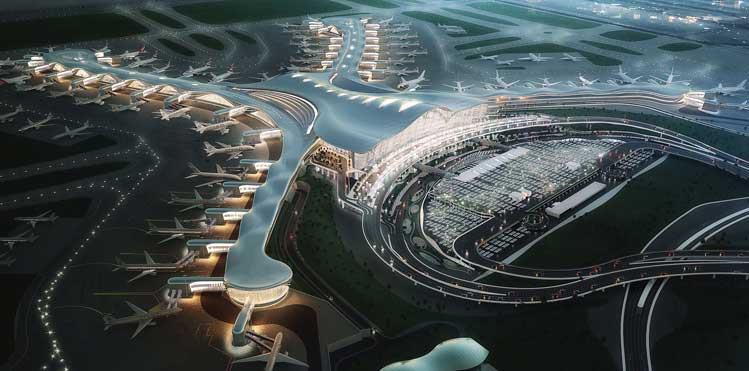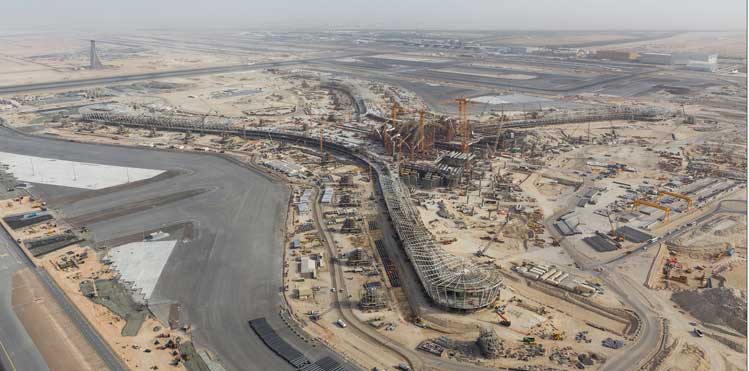Abu Dhabi’s growing economy and its increasing attraction for tourists, businesses and transit passengers, has necessitated the development of the impressive new Midfield Terminal Building (MTB).
National carrier Etihad Airways has implemented a phenomenally aggressive expansion plan, and it is essential that Abu Dhabi International Airport provides the infrastructure to enable it to achieve its objectives. Since 2006, annual passenger numbers have more than tripled, with double-digit percentage growth every month. “It is, therefore, all the more important for the highest quality transport infrastructure to be available in the Emirate,” stated Tony Douglas, CEO of Abu Dhabi Airports. “This starts and finishes with the capital’s airport, so it is vital for us to keep pace with the increasing inflow of passengers and offer them the best possible experience when they arrive and leave. We simply can’t finish the project soon enough.”
Progress has been excellent. The MTB has risen out of the ground and is fast becoming an iconic part of Abu Dhabi’s skyline. The last two years have seen many key milestones achieved; in particular, the erection of the first steel buttress in October 2013, followed by completion of the first steel arch in January this year. The central processing unit is nearing completion, and the steel structures on each of the four piers are now in place, together with other roof arches.

The scale of the project is truly impressive, covering 700,000sqm. The central space of the terminal building could hold three full-sized football pitches, and features a ceiling 52m tall at its highest point.
The project consists of two key phases: The four-year construction phase, followed by the Operational Readiness Assessment phase (ORAT) – a nine-month period in which thorough tests of all aspects of the terminal will take place to ensure operational and efficiency readiness from the first day of operation. “If we were to break down the programme into years, essentially 2013 was the year of the Midfield Terminal Complex’s (MTC) foundations, 2014 is the year of the roof, 2015 will be the year of systems integration, 2016 would be the fit out, and 2017 will be the year of testing, with enough time left to ensure that everything is 100% in working order before the terminal becomes operational,” Douglas explained.
The most important partner on the development is the government of Abu Dhabi, without whom the project would never have been initiated, while key partners on the main construction are TAV Construction, CCC, and Arabtec. “In terms of strategic partnership, of course our national carrier Etihad Airways remains our main partner in this journey to deliver a world-class air transport service from Abu Dhabi,” Douglas added.
Passenger experience at the core of the MTB project
The scale of the project is truly impressive, covering 700,000sqm. The central space of the terminal building could hold three full-sized football pitches, and features a ceiling 52m tall at its highest point, while the whole of Abu Dhabi International Airport’s Terminal 3 would fit into just a single one of the four piers being built.
“The MTC is a massive project requiring every single component to be planned in minute detail and executed to the most rigorous industry standards possible,” Douglas asserted. “That may sound simple, but when you consider that this has to be precisely applied in millions of different parts over several years, that is some challenge to a tight timetable and to a fixed budget. In response, we are doing everything we can to ensure that this simple but vital principle is adopted across the entire project.”
One of the most technologically sophisticated elements at the heart of the MTB is the baggage handling system. The Crisplant system has a throughput capacity to process up to 19,200 bags per hour and will integrate 25km of CrisBelt conveyors and the CrisBag tote-based transport and sorting system. Based on a ‘one bag per tote; one tote per section’ philosophy, CrisBag transports each item of baggage in a single tote throughout all of the screening, transport and sorting processes. “This enables CrisBag to enhance security and minimise bottlenecks in the flow of baggage through the screening process,” Douglas said.
He speaks with particular enthusiasm about the passenger experience, describing it as “a top priority at Abu Dhabi Airports and one that is at the core of everything we plan to offer at the new airport”. “The design focuses extensively on the passenger experience, and meets the IATA ‘A’ level of fast travel service with regards to speed and space for processing passengers, and will be capable of handling around 8,500 passengers per hour,” he added.
Indeed, the location of the MTB, between Abu Dhabi International Airport’s two runways, allows for the shortest possible journey from runway to parking stand, resulting in a quicker and smoother experience for passengers.

2013 was the year of the Midfield Terminal Complex’s foundations, 2014 is the year of the roof, 2015 will be the year of systems integration, 2016 would be the fit out, and 2017 will be the year of testing.
Flow of innovation and technology
The figures, meanwhile, are continually impressive; over 18,000sqm will be dedicated to retail and almost 10,000sqm to food & beverage. Innovation flows through all aspects of the development, incorporating the most advanced forms of technology available. “For example, we have implemented a revolutionary new tendering process for the duty free concessions at the MTB,” Douglas explained. “The innovation and technology of the tender packs served notice, both to potential bidders and to the industry, that only the very best and most innovative and imaginitive of concepts will be acceptable in such an iconic building.”
This innovative approach extends to the sustainable design of the MTB, which makes use of elements such as high performance and angled glass facades to avoid heat from entering the building, making air conditioning more efficient while providing natural daylight.
The MTB is an enormous undertaking that will go a long way to allowing Abu Dhabi to handle the massive growth in passenger numbers that is expected in the coming years. It will be the gateway to Abu Dhabi, and by 2020 more than 40 million passengers each year are expected to use Abu Dhabi International Airport. Ultimately, the MTB will play an important role in raising the profile of the Emirate as a world-class travel hub, enabling the diversification of the Emirate’s economy by fostering growth in other industries through increased connectivity.







